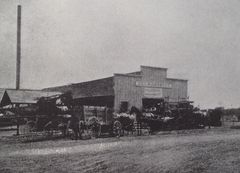George N. Herbert Packing Company
Lua error: Internal error: The interpreter exited with status 126.
‘’’George N. Herbert Packing Company’’’ was a dried fruit packer in San Jose from the early 1890’s through 1918. The principal for the company was George N. Herbert, a veteran San Jose fruit man Herbert sold his packing house to the California Prune and Apricot Growers in 1918. Within a year, Herbert started the ‘’’Herbert Packing Company’’ cannery, purchasing the Smith-Frank Canning Company.
Dried Fruit Packing House on Lincoln Ave.
Herbert was the son of a California immigrant; his brother, J.H. Herbert was also in the fruit industry. In 1898, Herbert built a one-story packing house at Lincoln and Moorpark Avenues[1]. That packing house burned on June 30, 1901 - losing 450 tons of prunes, and buildings covering an acre. The fire also set the adjacent narrow gauge tracks on fire. 250 tons were owned by the California Cured Fruit Association, rest belonged to Herbert except for 20 tons owned by Seglemen Brothers of New York, awaiting shipping instructions." The fire completely destroyed the "immense dryer and packing house on Lincoln Ave."; the immense piles of prunes glowed like a volcano”[2]. Herbert rebuilt his plant in 40 days as a three-story packing house in the middle of the Lincoln block.
Herbert did contract packing for the California Prune and Apricot Growers in 1917 in the organization’s first year[3]. After significant problems with the prices charged by contract packers, the association began buying packing houses, purchasing the Herbert packing house in 1918. The building became Sunsweet’s Plant #6.
Herbert also began buying land. "George N. Herbert has purchased 110 acres of the Thomas Fisher estate, a short distance south of Coyote, for between $70,000 and $75,000. Mr. Herbert stated that he purchased the property owing to the great richness of the soil, which he considers the best prune land in the valley. His 25 years' experience in the packing business has taught him that the largest and highest quality prunes are raised in the territory running from Edenvale to several miles south of Coyote. He stated also that the biggest production of prunes comes from this section.”[4]. Herbert sold the land in 1920 Douglas Sim for $150,000. The land included 100 acres of prunes and ten acres of apricots[5]. Headline showed it as largest sale of the year.
Herbert Packing Company: Cannery at Third and Keyes
In April 1919, Herbert returned to business with the purchase of the Smith-Frank Canning Company at Third and Keyes in San Jose. Frank, like Herbert, turned his packing house over to Sunsweet, and built a cannery for a second try at the fruit industry, but decided after a year to relocate to Sacramento. Herbert inherited a cannery that occupied an entire city block; he also planned to restart a dried fruit business. Directors for the new company included George N. Herbert, S. G. Tompkins, J. Q. Patton, B. H. Barthold of San Francisco (who was also superintendent), and D. W. Johnson of San Francisco[6]. Western Canner and Packer noted that they expected to can 130,000 cases of fruit in 1919, mostly apricots, peaches, pears, and cherr with a staff of 500Cite error: Closing </ref> missing for <ref> tag.
In 1922, Van Camp Packing considered entering the California market and considered buying the Herbert cannery. In early April, Van Camp decided against the move, and Herbert announced that he intended to stay independent, with both the dried and canned business expanding[7]. Harold A. Herbert would be in charge of production; H. J. Denhart would be in charge of sales, and John A. Kluge would head the export department. The same article notes Herbert Packing’s purchase of the Reedley Canning Company, purchased from Anderson Barngrover who received it through bankruptcy[8].
In 1923, Herbert contracted to can for the California Canning Peach Growers' Association in 1923 at his canneries at Reedley and San Jose. Each cannery was expected to process 160 to 200 tons of peaches a day to cover the association’s 10,000 tons of fruit; the value of the contract was expected to be $1,000,000. Herbert would advance the canning cost and handle selling. The growers had previously used the California Packing Corporation, but switched to Herbert and two smaller canners after a dispute over prices[9].
Herbert’s cannery still exists on the southeast corner of Third and Keyes[10].
Locations
| Location | Years | Address | Details |
|---|---|---|---|
| Coyote | 1916-1920 | Former Thomas Fisher estate orchards. | |
| Reedley | 1920- |
cannery for apricots, cling, and freestone peaches. | |
| Reedley | 1922 | ||
| San Jose | 1896-1902 | Lincoln Avenue corner of Moorpark |
Dried Fruit packing house, San Francisco Call 1900 list of dropoff locations for California Cured Fruit Association. |
| San Jose | 1902-1918 | Lincoln Avenue near Sansevain | |
| San Jose | 1919- | Third and Keyes (1919) |
Still exists. |
| San Jose | 1919 | Monterey Highway |
Dried fruit plant. |
References
- ↑ George N. Herbert: History of Coast Counties.
- ↑ Packing House Burned: Destruction of Herbert Co.’s Plant Causes $50,000 Loss: July 1, 1901 San Jose Evening News
- ↑ List of Sunsweet collection stations: July 21, 1917 San Jose Evening News.
- ↑ October 7, 1916 Pacific Rural Press.
- ↑ San Jose Evening News, April 22, 1920
- ↑ April 26, 1919 California Fruit News
- ↑ Herbert Packing Company Remains Independent: California Fruit News, April 1 1922.
- ↑ Van Camp Packing Company To Enter California Activity: California Fruit News, March 18, 1922
- ↑ Geo. Herbert Signs Contract for Peach Crop: San Jose Evening News, July 21, 1923
- ↑ Martha Gardens memorandum to San Jose city planning commission: document.
